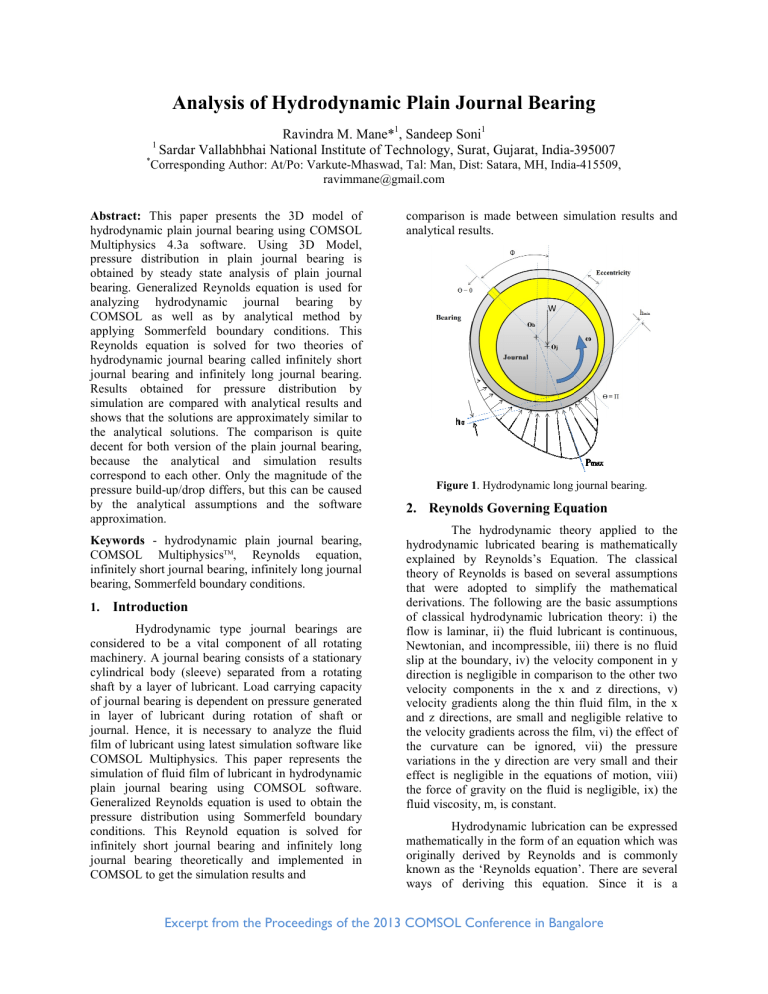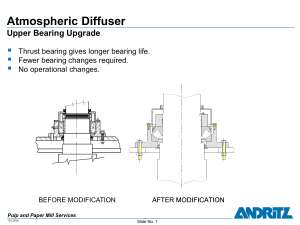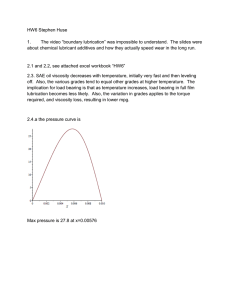
Analysis of Hydrodynamic Plain Journal Bearing 1 * Ravindra M. Mane*1, Sandeep Soni1 Sardar Vallabhbhai National Institute of Technology, Surat, Gujarat, India India-395007 Corresponding Author: At/Po: Varkute Varkute-Mhaswad, Mhaswad, Tal: Man, Dist: Satara, MH, India-415509, India ravimmane@gmail.com Abstract: This paper presents the 3D model of hydrodynamic plain journal bearing using COMSOL Multiphysics 4.3a software.. Using 3D Model, pressure distribution in plain journal bearing is obtained by steady state analysis of plain journal bearing. Generalized Reynolds lds equation is used for analyzing hydrodynamic journal bearing by COMSOL as well as by analytical method by applying Sommerfeld boundary conditions. This Reynolds equation is solved for two theories of hydrodynamic journal bearing called infinitely short journal bearing and infinitely long journal bearing. Results obtained for pressure distribution by simulation are compared with analytical results and shows that the solutions are approximately similar to the analytical solutions. The comparison is quite decent ecent for both version of the plain journal bearing, because cause the analytical and simulation results correspond to each other. Only the magnitude of the pressure build-up/drop up/drop differs, but this can be caused by the analytical assumptions and the software approximation. Keywords - hydrodynamic plain journal bearing, COMSOL MultiphysicsTM, Reynolds equation, infinitely short journal bearing, infinitely long journal bearing, Sommerfeld boundary conditions. 1. Introduction Hydrodynamic type journal bearings are considered to be a vital component of all rotating machinery. A journal bearing consists of a stationary cylindrical body (sleeve) separated from a rotating shaft by a layer of lubricant. Load carrying capacity of journal bearing is dependent on pressure ggenerated in layer of lubricant during rotation of shaft or journal. Hence, it is necessary to analyze the fluid film of lubricant using latest simulation software like COMSOL Multiphysics. This paper represents the simulation of fluid film of lubricant in hydrodynamic plain journal bearing using COMSOL software. Generalized Reynolds equation is used to obtain the pressure distribution using Sommerfeld boundary conditions.. This Reynold equation is solved for infinitely short journal bearing and infinitely lo long journal bearing theoretically and implemented in COMSOL to get the simulation results and comparison is made between simulation results and analytical results. Figure 1. Hydrodynamic long journal bearing. bearing 2. Reynolds Governing Equation The hydrodynamic theory applied to the hydrodynamic lubricated bearing is mathematically explained by Reynolds’s Equation. The classical theory of Reynolds is based on several assumptions that were adopted to simplify the mathematical derivations. The following owing are the basic assumptions of classical hydrodynamic lubrication theory: theory i) the flow is laminar, ii) the he fluid lubricant is continuous, continuous Newtonian, and incompressible, iii) iii there is no fluid slip at the boundary, iv) the he velocity component in y direction is negligible in comparison to the other two tw velocity components nts in the x and z directions, v) v velocity gradients along the thin fluid film, in the x and z directions, are small and negligible relative to the velocity gradients across the film, film vi) the effect of the curvature can be ignored,, vii) the pressure variations in the y direction are very small and their effect is negligible le in the equations of motion, viii) vii the he force of gravity on the fluid is negligible, negligible ix) the fluid viscosity, m, is constant. Hydrodynamic lubrication can be expressed mathematically in the form of an equation which was originally derived by Reynolds and is commonly known as the ‘Reynolds equation’. There are several ways of deriving this equation. Since it is a Excerpt from the Proceedings of the 2013 COMSOL Conference in Bangalore simplification of the Navier-Stokes Stokes momentum and continuity equation it can be derived from this basis. It is, however, more often derived by considering the equilibrium of an element of liquid subjected to viscous shear and applying the continuity of flow principle. Figure 3. Shows typical configuration for thin-film thin flow. 4. Results and Discussion The steady state analysis of plain journal bearings has been carried out for the case of infinitely long journal bearing and infinitely short journal bearing at eccentricity ratios of 0.5 with constant length to diameter ratio. Following data is selected for infinitely short and infinitely long journal bearing. Table 1: Plain journal bearing dimensions and oil properties. Figure 2. Fluid element from hydrodynamic film film. The Reynolds equation for Newtonian incompressible and constant-viscosity viscosity fluid in a thin clearance between two rigid surfaces of relative motion is given by; ∂ h ∂p ∂ h ∂p ∂x µ ∂x ∂z µ ∂z 6U ∂h h ∂xx 1 This is the common Reynolds equation is widely used for solving the pressure distribution of hydrodynamic bearings. By applying boundary conditions of short and long journal bearing above equation reduced following two equations; ∂ h ∂p ∂x µ ∂x ∂ ∂h 6U ∂ ∂x 2 This is the equation for long journal bearing. ∂ h ∂p ∂z µ ∂z 6U ∂ ∂h ∂ ∂x 3 This is the equation for short journal bearing. Where, h is the variable film thickness is due to the journal eccentricity; h θ c 1 ε cos θθ 4 3. Use of COMSOL The models described in this paper were constructed using COMSOL Multiphysics v4.1 v4.1a running on a computer with CAD LAB of Chemical Engineering Department, SVNIT Surat, Gujarat, India on windows 7.. For this analysis thin film flow physics with CFD model of journal bearing is used. Parameters Length Diameter of journal L/D ratio Radial Clearance Eccentricity Eccentricity ratio Speed of journal Dynamic Viscosity of Oil Inlet Temperature Short Bearing 0.025[m] Long Bearing 0.125[m] 0.05[m] 0.05[m] 0.5 2.5 x 10-5[m] 1.25 x 10-5[m] 0.5 1000[rpm] 2.5 2.5 x 10-5 [m] 1.25 x 10-5 [m] 0.5 1000[rpm] 0.19[Pa.s] 0.19[Pa.s] 315[K] 315[K] Pressure distribution have been determined by using COMSOL software and compared with analytical results. The results obtained have plotted for comparisons for eccentricity ratio of 0.5 with full Sommerfeld boundary conditions. After simulation pressure distribution on journal surface has been found out as contour representation. The maximum pressure is reached in a region closer to the minimum fluid film thickness and negative pressure results due to appropriate boundary conditions. The pressure distribution and pressure contours rs are shown in figure fig 4 & 5 respectively for long and short journal bearing. At the boundary pressure is zero and maximum at midline in axial direction. Therefore the pressure distribution is plotted along the midline of the plain journal bearing and compared ared with the analytical solutions. Excerpt from the Proceedings of the 2013 COMSOL Conference in Bangalore Figure 4. 3D pressure distribution for LJB using full Sommerfeld condition at eccentricity ratio, ε = 0.5. Figure 5. 3D pressure distribution for SJB using full Sommerfeld condition at eccentricity ratio, ε = 0.5. Figure 6. Comparison of analytical and simulated pressure distribution for LJB using full Sommerfeld condition at eccentricity ratio, ε = 0.5. Figure 7. Comparison of analytical and simulated pressure distribution for SJB using full Sommerfeld condition at eccentricity ratio, ε = 0.5. The plain journal bearing has only one high point pressure along the circumference of the journal bearing. This is due to geometry of bearing and how the fluid gap expands and contracts once around the circumference of the journal shaft. A typical pressure distribution along the circumference of the journal shaft of the journal bearing is shown in figure 4 & 5, respectively for long and short journal bearing. Results for pressure distribution obtained by simulation are compared with analytical solution and using graph of pressure vs. angle along circumferential direction shown in figure 6 & 7, respectively for long and short journal bearing and found that they are approximately matching. The solutions of these simulations are approximately similar to the analytical solutions of the plain journal bearing. The comparison is quite decent for both version of the plain journal bearing, because the analytical and software solutions correspond to each other. Only the magnitude of the pressure buildup/drop differs, but this can be caused by the analytical assumptions and the software approximation. Hence solution obtained by simulation gets validated. Figure 8. Polar plot for LJB showing comparison of pressure by analytical and simulation around the journal bearing using full Sommerfeld condition at eccentricity ratio ε = 0.5. Figure 9. Polar plot for SJB showing comparison of pressure by analytical and simulation around the journal bearing using full Sommerfeld condition at eccentricity ratio ε = 0.5. Excerpt from the Proceedings of the 2013 COMSOL Conference in Bangalore Figure 10. Comparison of pressure distribution for LJB using full Sommerfeld condition at eccentricity ratio, ε = 0 to 0.9. Figure 11. Comparison of pressure distribution for SJB using full Sommerfeld condition at eccentricity ratio, ε = 0 to 0.9. 5. Conclusion 6. References The pressure distribution of the hydrodynamic plain journal bearing lubricated with oil under steady state consideration has been analyzed.. Based on the results and discussion presented in the preceding section, the following conclusions can be made for plain journal bearing studied. 1. General governing Reynolds equation is derived and implemented for hydrodynamic plain journal bearing. Using Reynolds equation analytical model is developed for infinitely short and infinitely long journal bearing to find steady state characteristics of plain journal bearing. Furthermore, this analytical model is implemented in COMSOL Multiphysics software for more advanced design and analysis. Using COMSOL pressure distribution for plain journal bearing is simulated and compared with analytical solution. It is found that COMSOL gives approximately identical solution for both short and long journal bearing, hence COMSOL solution get validated with analytical solution and for CFD module has no problem to generate the so solution for journal bearing. The graph shown in figure 10 & 11, shows that increase in the maximum pressure also seems to be more severe. The pressure increases as the direction of eccentricity for a plain journal bearing bearing, at low eccentricity ratio pressure is low and at high eccentricity ratio pressure is high. As shown in figure 10 & 11, the COMSOL analysis correlates very well with analytical solution using the Sommerfeld analysis. At lower eccentricity values COMSOL predicts a slightly lower maximum pressure sure while at the higher values of eccentricity it predicts a slightly higher maximum pressure. 2. 3. 4. 5. 6. 7. 8. 9. Naffin R. K., Chang L., ‘An Analytical Model for the Basic Design Calculations of Journal Bearings’, Journal of Tribology, ASME, ASME Vol. 132(2), April 2010, USA. Cromton J. S., Gritter L. T., Yushanov Y. S., Kopenhoefer K. C., Edwards R. O., ‘Analysis of Lubricant icant Flow through Reynolds Equation’, Multiphysics Simulation Conference, COMSOL Proceedings, 2010, Boston. Gertzos K. P., Nikolakopoulos P. G., Papadopoulos, ‘CFD Analysis of journal bearing hydrodynamic lubrication by Bingham lubricant’, Tribology International, Elsevier Publication, Vol. 41, pp. 1190-1204, 1190 2008. Deligant M., Podevin P., Descombes G., ‘CFD model for turbocharger journal bearing performances’, Applied Thermal Engineering, Elsevier Publication,, Vol. 31, pp. 811-819, 811 2011. Shenoy B. S., ., Pai R. S., Rao D. S., Pai R., ‘Elast‘Elast hydrodynamic analysis of full 3600 journal bearing using CFD and FSI techniques’, World Journal of Modeling and Simulation, World Academic press,, Vol. 5, pp. 315-320, 315 2009, UK. Molka A. H., Slim B., Mohamed M., Tahar F., Mohamed H., ‘Hydrodynamic and Elastohydrodynamic studies of a cylindrical journal bearing’, Journal of Hydrodynamics, Elesvier Publication,, Vol. 22, pp. 155-163, 155 2010. Andres L. S., Hydrodynamic Fluid Film Bearings and Their Effect on the Stability of Rotating Machinery’, Design and Analysis of High Speed Pumps, Educational Notes RTO-ENRTO AVT-143, Vol. 10, pp. 1-36, 36, 2006, France. Ouadoud A., Mauchtachi A., Boutammachte N., ‘Numerical simulation CFD, FSI of a hydrodynamic journal bearing, Journal of Advanced Research earch in Mechanical Engineering, Hyper Sciences Publisher, Vol. 2, pp. 33-38, 2011. Kasolong S., Ahmad M. A., Joyce R. D., Taib C. F. M., ‘Preliminary study of Pressure Profile in Excerpt from the Proceedings of the 2013 COMSOL Conference in Bangalore 10. 11. 12. 13. 14. 15. 16. 17. 18. 19. 20. 21. 22. Hydrodynamic Lubrication Journal Bearing’, Procedia Engineering, Elesvier Publication, Vol. 41, pp. 1743-1749, 2012. Nuruzzaman D. M., Khalil M. K., Chawdhury M. A., Rahman M. I., ‘Study on Pressure Distribution and Load Capacity of a Journal Bearing Using Finite Element Method and Analytical Method’, International Journal of Mechanical & Mechatronics Engineering IJMME-IJENS, Vol. 10. Wolfinger P., ‘Analysis of Various Parameters Associated with Oil Lubricated Journal Bearings’, M.Tech Thesis, Rensselaer Polytechnic Institute, Hartford, 2011, USA. Stachowiak G. W. and Batchelo A. W., ‘Engineering Tribology’, Third Edition, Elsevier Butterworth Heinemann Publication, 2011. Harnoy A., ‘Bearing Design in Machinery: Engineering Tribology and Lubrication’, M. Dekker, 2003, New York. Khonasari M. M. and Booser R. E., ‘Applied Tribology: Bearing Design and Lubrication’, Second Edition, John Wiley & Sons Inc, 2008, UK. Yukio H., ‘Hydrodynamic Lubrication’, Springer Publication, 2006, Tokyo. Hamrock B. J., ‘Fundamentals of Fluid Film Lubrication’, McGraw-Hill, 1994, New York. Gopinath K. & Mayuram M. M., ‘Machine Design II’, NPTEL E-Learning Courses from IITs and IISc. Hirani H., ‘Tribology: Video Lectures’, NPTEL E-Learning Courses from IITs and IISc. COMSOL Multiphysics 4.3 User’s Guide, COMSOL, 2012, U.S. COMSOL Multiphysics 4.3 Reference Guide, COMSOL, 2012, U.S. COMSOL Technical Support for online information, www.comsol.com/support. COMSOL Multiphysics , CFD Model User’s Guide, COMSOL, 2012, U.S Excerpt from the Proceedings of the 2013 COMSOL Conference in Bangalore


